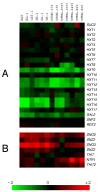Improved Sugarcane-Based Fermentation Processes by an Industrial Fuel-Ethanol Yeast Strain
- PMID: 37623574
- PMCID: PMC10456111
- DOI: 10.3390/jof9080803
Improved Sugarcane-Based Fermentation Processes by an Industrial Fuel-Ethanol Yeast Strain
Abstract
In Brazil, sucrose-rich broths (cane juice and/or molasses) are used to produce billions of liters of both fuel ethanol and cachaça per year using selected Saccharomyces cerevisiae industrial strains. Considering the important role of feedstock (sugar) prices in the overall process economics, to improve sucrose fermentation the genetic characteristics of a group of eight fuel-ethanol and five cachaça industrial yeasts that tend to dominate the fermentors during the production season were determined by array comparative genomic hybridization. The widespread presence of genes encoding invertase at multiple telomeres has been shown to be a common feature of both baker's and distillers' yeast strains, and is postulated to be an adaptation to sucrose-rich broths. Our results show that only two strains (one fuel-ethanol and one cachaça yeast) have amplification of genes encoding invertase, with high specific activity. The other industrial yeast strains had a single locus (SUC2) in their genome, with different patterns of invertase activity. These results indicate that invertase activity probably does not limit sucrose fermentation during fuel-ethanol and cachaça production by these industrial strains. Using this knowledge, we changed the mode of sucrose metabolism of an industrial strain by avoiding extracellular invertase activity, overexpressing the intracellular invertase, and increasing its transport through the AGT1 permease. This approach allowed the direct consumption of the disaccharide by the cells, without releasing glucose or fructose into the medium, and a 11% higher ethanol production from sucrose by the modified industrial yeast, when compared to its parental strain.
Keywords: bioethanol; fermentation; sugarcane; yeast.
Conflict of interest statement
The authors declare no conflict of interest. The funders had no role in the design of the study; in the collection, analyses, or interpretation of data; in the writing of the manuscript; or in the decision to publish the results.
Figures






Similar articles
-
Effects of feedstock and co-culture of Lactobacillus fermentum and wild Saccharomyces cerevisiae strain during fuel ethanol fermentation by the industrial yeast strain PE-2.AMB Express. 2018 Feb 16;8(1):23. doi: 10.1186/s13568-018-0556-9. AMB Express. 2018. PMID: 29453625 Free PMC article.
-
Sucrose fermentation by Saccharomyces cerevisiae lacking hexose transport.J Mol Microbiol Biotechnol. 2004;8(1):26-33. doi: 10.1159/000082078. J Mol Microbiol Biotechnol. 2004. PMID: 15741738
-
Comparative Genomics Supports That Brazilian Bioethanol Saccharomyces cerevisiae Comprise a Unified Group of Domesticated Strains Related to Cachaça Spirit Yeasts.Front Microbiol. 2021 Apr 15;12:644089. doi: 10.3389/fmicb.2021.644089. eCollection 2021. Front Microbiol. 2021. PMID: 33936002 Free PMC article.
-
From baker's yeast to genetically modified budding yeasts: the scientific evolution of bioethanol industry from sugarcane.FEMS Yeast Res. 2021 Jan 6;20(8):foaa065. doi: 10.1093/femsyr/foaa065. FEMS Yeast Res. 2021. PMID: 33406233 Review.
-
Saccharomyces cerevisiae strains used industrially for bioethanol production.Essays Biochem. 2021 Jul 26;65(2):147-161. doi: 10.1042/EBC20200160. Essays Biochem. 2021. PMID: 34156078 Review.
Cited by
-
Comparative Genomics and Characterisation of the Role of Saccharomyces cerevisiae Respiration in the Fermentation of Chinese Steamed Bread.J Fungi (Basel). 2025 Feb 3;11(2):114. doi: 10.3390/jof11020114. J Fungi (Basel). 2025. PMID: 39997408 Free PMC article.
-
A Comprehensive Review of the Diversity of Fungal Secondary Metabolites and Their Emerging Applications in Healthcare and Environment.Mycobiology. 2024 Dec 3;52(6):335-387. doi: 10.1080/12298093.2024.2416736. eCollection 2024. Mycobiology. 2024. PMID: 39845176 Free PMC article. Review.
References
-
- CONAB—Companhia Nacional de Abastecimento—Acompanhamento da Safra Brasileira de Cana-de-Açúcar—Safra 2022/23. [(accessed on 2 March 2023)]; Available online: https://www.conab.gov.br/info-agro/safras/cana/boletim-da-safra-de-cana-....
-
- Jaiswal D., de Souza A.P., Larsen S., LeBauer D.S., Miguez F.E., Sparovek G., Bollero G., Buckeridge M.S., Long S.P. Brazilian sugarcane ethanol as an expandable green alternative to crude oil use. Nat. Clim. Chang. 2017;7:788–792. doi: 10.1038/nclimate3410. - DOI
-
- do Nascimento e Silva J.H., Verruma-Bernardi M.R., de Oliveira A.L. Cachaça production in Brazil and its main contaminant (ethyl carbamate) Sci. Agric. 2018;77:e20180135. doi: 10.1590/1678-992x-2018-0135. - DOI
Grants and funding
LinkOut - more resources
Full Text Sources
Molecular Biology Databases

